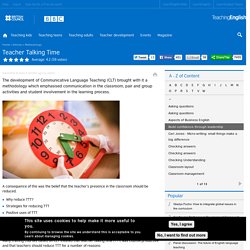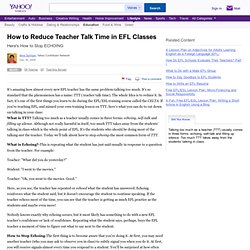

How to Reduce the Amount of Teacher Talk. Pair Sharing: A Best Practice Pair Sharing is generally acknowledged as a best practice in education.

In classrooms I visit, however, I rarely see it used, let alone integrated into lessons as a regular practice. Reducing the amount of teacher talk and getting students to talk to each other is one of the cheapest and easiest education reforms anyone can implement. The structure of schooling must change to become more child-centered or it risks becoming irrelevant. Teachers need to get off the stage a little bit and here’s a way to do it without giving up complete control.
I was lucky enough to be trained in the GLAD strategies early in my teaching career and their philosophy of 10-2 greatly influenced my thinking about pair sharing. Having student summarize what you’ve been teaching helps students to: Having students summarize what you’ve been teaching helps teachers to: Assess whether students understand what you’re talking about.
Classroom Management Other Uses for Pair Sharing. Tips for reducing TTT (teacher talk time) in TEFL. Obviously as a teacher when you are teaching you need to teach which generally means talking!

However, if you speak too much you take away the opportunities for your students to peer teach, interact and practice their speaking skills. Here are some basic tips for reducing TTT and increasing STT: Don’t read out the questions for them to answer from the worksheet. They can do that and gives you an opportunity to work on some pronunciation with themHave a list of eliciation questions ready to keep a discussion goingIf you have planned a pair work activity and have an odd number, get them to work as a group.
As always, keep it fun, relevant and professional! TEFL activities in the classroom. TECHNIQUES FOR REDUCING TEACHER TALK TIME by Ivan Senisse on Prezi. TEFL Tip #8 - How Can I Reduce My Teacher Talking Time? Teacher Talking Time. A consequence of this was the belief that the teacher’s presence in the classroom should be reduced.

Www.bridgetefl.com/shut-up-how-to-reduce-your-teacher-talk-time-in-the-efl-classroom/ « Back to The TEFL Insider By Matthew Clark on Friday Apr 8, 2011 Teacher Talk Time – or TTT - in the EFL classroom is often perceived negatively.

In recent years, benefits of TTT have entered the conversation (please follow this link for a brief overview of the pros and cons: In my opinion, the most important aspect of TTT is your ability to control it in the classroom. For many teachers, this means talking less! To be honest, I don’t believe I ever mastered the art of limiting my TTT. Becoming an experienced, effective “language guide” can take years, but here are three simple ways to limit your Teacher Talk Time and put you on the path to becoming a great teacher: Be okay with silence!
Remember, foreign language study is full of funny misunderstandings and mistakes. About the AuthorMatthew Clark Originally from Colorado, Matt earned a bachelor’s in English literature from Wichita State University in Kansas, while also playing for the men’s basketball team. #TeacherTalk. We all love to talk in the classroom!

Students disagree; and so do Ofsted. TeacherTalk can often be the root-cause of poor behaviour and debilitating progress during a lesson. More often than not, I’ve observed many lessons and have watched teachers ‘say all the right things’ during my time in their classrooms, hoping for me to tick a box! Talking more, saying all the right things during an observation, reduces the opportunities for students to share, and in turn hinders their own learning process.
Here is where the problem lies: Firstly, do not tick boxes. This page has evolved as a result of my own leadership of whole-school Teaching and Learning and as a priority we identified during 2011/12. As I collate ideas and strategies, I will post them here for editing and will create a document to share on TES Resources. How to Reduce Teacher Talk Time. How to Reduce Teacher Talk Time Reducing teacher talk time (TTT) and increasing student talk time (STT) is an important aspect of creating a communicative classroom.

Here are some strategies to reduce teacher talk time: Elicit Elicit answers and concepts from students.Concept check understanding of new words and structures. Don’t over explain. Body Language Use body language, gestures, props, and the board to explain. Instructions Make instructions simple and concise to avoid explaining them multiple times. Echoing Don’t echo student responses. Questions Ask open-ended questions, not yes/no questions.Use “why” and “how” to prompt student explanations.Ask follow-up questions. Participation Encourage all students to participate.Students should read instructions, examples, exercise questions, and anything else that is possible.
Study Methods Use inductive methods to teach new ideas. Teacher talking time. Reducing Teacher Talking Time. Reducing Teacher Talking Time [A version of this originally appeared in KOTESOL's "The English Connection" and was co-written with Manpal Sahota] The famous American educator John Holt wrote, “The greatest enemy to student learning is the talking teacher.”

This quote is probably more accurate in EFL classrooms, and especially here in South Korea. Part One. At one time teacher talking time (TTT) was seen as being inevitably counterproductive and something to be limited as much as possible.

Why? There are five main arguments against it : A large amount of TTT necessarily limits the amount of STT (student talking time). For example, in a 60 minute class, if the teacher is talking for a total of 45 minutes, that leaves only fifteen minutes left for the students. If there are ten in the class, they’ll get only 90 seconds each to speak. Teacher Talk Time / Student Talk Time. Most teachers readily agree that the students should receive as much opportunity to speak as is possible when learning English as a foreign language.

This idea is especially true in the EFL classroom, where students don't live in an English-speaking country. In such cases, the students may only have the chance to practice English as a conversational tool during the sixty or ninety minutes of the lesson. But whatever the situation, the more students speak in English, the better English speakers they become. Teacher Talking Time. Vladimira's blog - #ELTchat – TEACHER TALKING TIME vs STUDENT TALKING TIME. How to Reduce Teacher Talk Time in EFL Classes. It's amazing how almost every new EFL teacher has the same problem-talking too much.

It's so standard that the phenomenon has a name: TTT ( teacher talk time). The whole Idea is to reduce it. In fact, it's one of the first things you learn to do during the EFL/ESL training course called the CELTA. If you're teaching EFL, and missed your own training lesson on TTT, here's what you can do to cut down on talking in your class: